Although there is a difference between lichens and moss, the terms will be used relatively interchangeable for this brief write up, as many lichens are commonly referred to as mosses. As for real mosses, few are edible, but they are often used as filters and natural antibiotics. Do to the time required for preparation, and the side effects of poorly prepared lichens, these should generally be avoided as a go to food if stranded in the wilderness.
While almost every lichens are edible, it does not mean they are nutritious or even palatable; but they can be eaten. Most of the benefits ascribed to moss are medical, many claiming that they are antiseptic and some are analgesic. As with many natural remedies, few studies have either confirmed or denied the medical claims. Lichen are bitter, acidic, and at best bland. But as plants, they have some vitamins and often contain minerals leeched from the soils and decay they grow on.
Due to its tight leafy nature moss will trap lots of insects, dirt, and other debris; so as with all other leafy greens, thoroughly wash before you prepare. As moss will often grow over top of other moss, do not dig deep into decaying material and ensure what you are picking is the fresh material on the surface. Decomposing material can bring along unhealthy doses of rot, bacteria, and other pathogens.
Beneficially moss can be easily found year round, notably in winter months on tree trunks, rocks, and other exposed surfaces; so while not generally desirable, it is a survival food to tuck away in your knowledge bank.
What varieties of moss all share is acid and as such require proper preparation if they are to be eaten, because unprepared and uncooked they will painfully attack your digestive track. Unprepared moss taste like aspirin. That should motivate you to prepare it correctly. Never eat unprepared and raw moss unless your life truly depends upon it. It probably will not kill you but you will wish it had.
Although there are a few common names used, there are many varieties of lichen and they can be quite complicated in differentiating, as with many types of fungi and mushrooms. However, while 96% of the 10,000 species of mushrooms are not edible (including the one to four percent that will definitely kill you); only two lichen out of some 20,000 are what we would call poisonous, Letharia vulpina and Vulpicida pinastri, or Wolf Lichen and Powdered Sunshine Lichen… and conveniently they are both yellow, Wolf Lichen a greenish yellow and the Sunshine Lichen a sulphur yellow. In short, if it has yellow to the color think of it as a warning, and stick with the stuff that is pale bluish and grey in color. And though internally toxic from vulpinic acid they can be used on external wounds and sores.
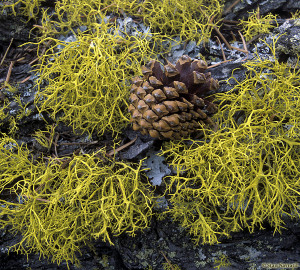
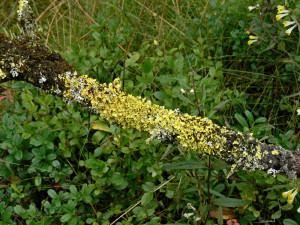
To make lichen edible they should be soaked in several changes of water, with Sodium bicarbonate (baking soda) added to each soaking, if you have it. Another method is to soak them with hardwood ashes. The modern version of that is to soak them in a 1% solution of potash. A method used in China is to boil lichen for 30 minutes and then soak for two days in several changes of water. After discarding the soaking water they are boiled and that water discarded, or they are steamed. They are then ready to eat, plain or mixed with other things, or dried and added to flour or as a thickener to soups. Moss or Lichen is often cooked until it turns into a gelatinous mass; Cladonia islandica was used to thicken jelly until gelatins came along. The point is the longer you soak them and the longer you boil them and the more often you change the water, the more palatable they will be and the less acidic.
Below are three common varieties often referred to as Mosses, although there are many more. Lichens can be up to 96% carbohydrates after being leeched of the acid.
Reindeer Moss

Cladonia rangiferina, also known as reindeer lichen, is a light-colored, fruticose lichen belonging to the Cladoniaceae family. It grows in both hot and cold climates in well-drained, open environments. Found primarily in areas of alpine tundra, it is extremely cold-hardy. Cladonia rangiferina often dominates the ground in boreal pine forests and open, low-alpine sites in a wide range of habitats, from humid, open forests, rocks and heaths.
Other common names include reindeer moss and caribou moss, but these names may be misleading since it is not a moss. Reindeer moss is a low-growing plant only a few centimeters tall. It does not flower but does produce bright red reproductive structures.
The entire plant is edible but has a crunchy, brittle texture. Soak the plant in water as mentioned above. It was also used in the making of Swedish brandy and vodka. Best when prepared as a tea, but can also be entirely eaten.
Oak Moss
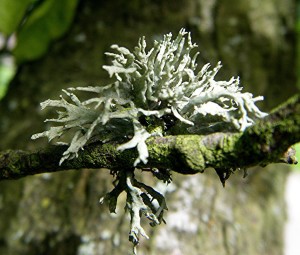
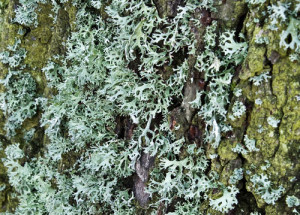
An edible lichen, Oak moss, also known as Evernia prunastri, is a type of lichen used extensively in modern perfumery. It has a pale greenish-grey body, 3-8 cm long, with pointed branches. This lichen can be found in many mountainous temperate forests throughout the Northern Hemisphere, including parts of France, Portugal, Spain, North America, and much of Central Europe. Oak moss grows primarily on the trunk and branches of oak trees, but is also commonly found on the bark of other deciduous trees and conifers such as fir and pine. The thalli of Oak moss are short (3-4 cm in length) and bushy, and grow together on bark to form large clumps. Oak moss thallus is flat and strap-like. They are also highly branched, resembling the form of deer antlers. The color of Oak moss ranges from green to a greenish-white when dry, and dark olive-green to yellow-green when wet. The texture of the thalli are rough when dry and rubbery when wet.
Spanish Moss

Spanish moss (Tillandsia usneoides) closely resembles its namesake (Usnea, or beard lichen). However, Spanish moss is not biologically related to either mosses or lichens. Instead, it is a flowering plant in the family Bromeliaceae (the bromeliads) that grows hanging from tree branches in full sun or partial shade. Formerly this plant has been placed in the genera Anoplophytum, Caraguata and Renealmia. It ranges from the southeastern United States (southern Virginia and eastern Maryland) to Argentina, growing wherever the climate is warm enough and has a relatively high average humidity.
The plant consists of a slender stem bearing alternate thin, curved or curly, heavily scaled leaves 2-6 cm long and 1 mm broad, that grow vegetatively in chain-like fashion (pendant) to form hanging structures 1-2 m in length, occasionally more. The plant lacks roots and its flowers are tiny and inconspicuous. It propagates both by seed and vegetatively by fragments that blow on the wind and stick to tree limbs, or are carried by birds as nesting material.
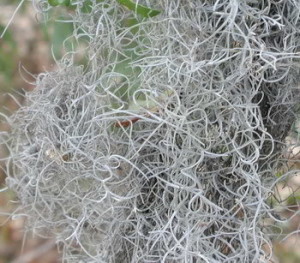
Spanish moss has almost no nutritional value and should not be ingested as a plant. Medicinal use of Spanish moss has a long history. It was taken, while green, and brewed into tea for expectant mothers, supposedly to aid the flow of breast milk and make the delivery easier. Tea from the plant was also used as a folk remedy for rheumatism. In Mexico, it has been used to treat infantile epilepsy. In the early 1950s, it was used as an estrogen substitute and scientists have found the plant exhibits antibacterial properties. Drugs extracted from it have been used in the treatment of diabetes and researchers have been looking for a way to use it to help control blood glucose levels.
Iceland Moss

Iceland moss (Cetraria islandica) is a lichen whose erect or upright, leaflike habit gives it the appearance of a moss, where its name likely comes from. It is often of a pale chestnut color, but varies considerably, being sometimes almost entirely greyish-white; and grows to a height of from 3 to 4 in., the branches being channelled or rolled into tubes, which end in flattened lobes with fringed edges.
It grows abundantly in the mountainous regions of northern countries, and it is specially characteristic of the lava slopes and plains of the west and north of Iceland. It is found on the mountains of north Wales, northern England, Scotland and south-west Ireland. In North America its range extends through Arctic regions, from Alaska to Newfoundland, and south in the Rocky Mountains to Colorado, and to the Appalachian Mountains of New England.
The whole plant is edible with some preparation. (Cetraria Islandica) is probably the most useful of the lichens for human consumption. It has a bitter astringent taste that can be removed by boiling and adding a spoonful of baking soda to the water. In Icelandic countries it is used to make jelly, gruel porridge, in salads and bread.
Before the lichens were used it was boiled in lye, rinsed in cold water, dried and stored in closed containers, stored in a dry place, it would keep for many years. In bread it was first oven dried, ground fine, ¼ grain meal was added and mixture was baked as usual producing a strong bread, which fair taste that kept well.
Rock Tripe
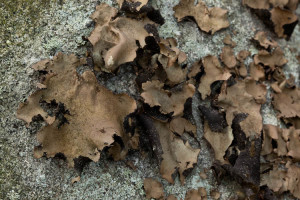
Rock tripe is the common name for various lichens of the genus Umbilicaria that grows on bare rocks, moist, open woods and cliffs. They can be found throughout northern parts of North America such as New England and the Rocky Mountains. They are edible when properly prepared and have been used as a famine food in extreme cases when other food sources were unavailable, as by early American northern explorers.
The whole plant. This is a last resort survival food, and make sure you prepare correctly. A group of explorers did not process it correctly and suffered from severe side effects such as extreme bowel issues, nausea and other illnesses. Boil with baking soda as stated with other lichen species, or at least soak it to become more digestible. Snip off the gritty parts of the base where they are attached to the rocks, wash over and over and over again in running water if possible. In a pan roast slowly until it becomes dry and crisp, then drop into boiling water and boil for 1 hour. Eat hold or cold, as soup or pudding. It has been remarked by other explorers as remarkably good and pleasing. When natives would run out of food this is what they would go and find, they would boil it to provide a nourishing gelatin to feed his children.
Umbilicaria esculenta is commonly used as a food in Asian cuisine and a restorative medicine in traditional Chinese medicine. It is called shi’er (石耳 “rock ear”) in Chinese cuisine, iwatake (岩茸 “rock mushroom”) in Japanese cuisine, and seogi (석이버섯) in Korean cuisine.
Rock Tripe is a group of leaf shaped lichens that are attached at their centers to non-calcareous (mostly granite) rocks. They are almost circular and flat, smooth or covered in blisters and pits. They are greyish to dark-brown or black. Undersides are often darker and velvety. When they are moist they are leathery or rubbery, and a most easily collected in this condition.
Assorted Wikipedia pages
http://www.greatnorthernprepper.com/survival-foraging-post-1-lichen/
http://mentalfloss.com/article/67807/10-things-you-should-know-about-spanish-moss
http://eatingwild.blogspot.com/2012/11/do-you-have-stomach-for-moss-and-lichens.html
http://www.survivalistboards.com/showthread.php?t=9409

Is mood moss edible?